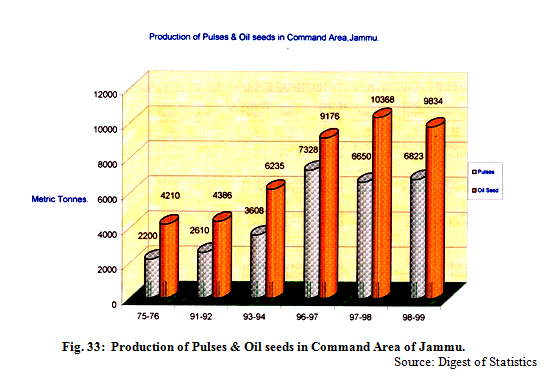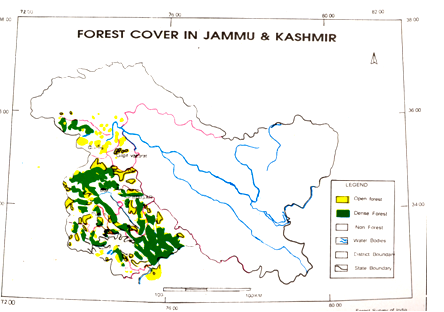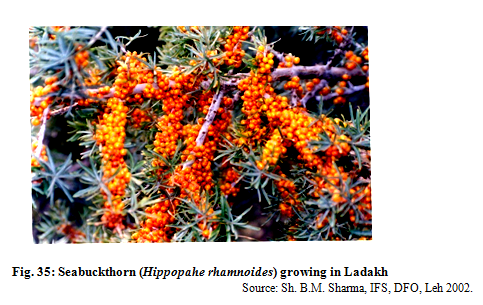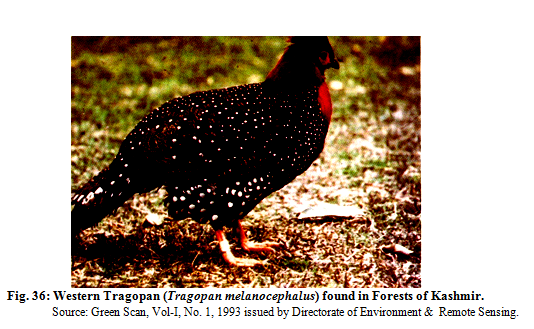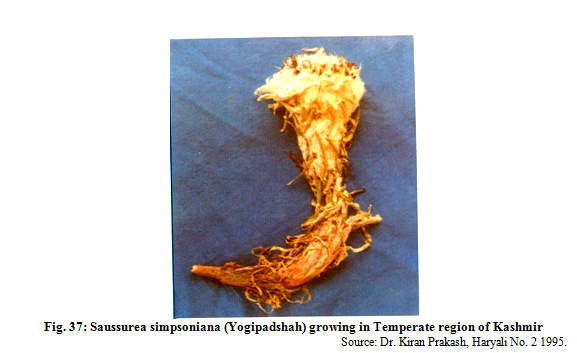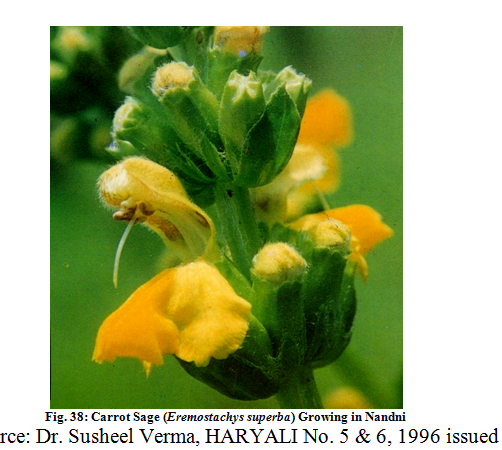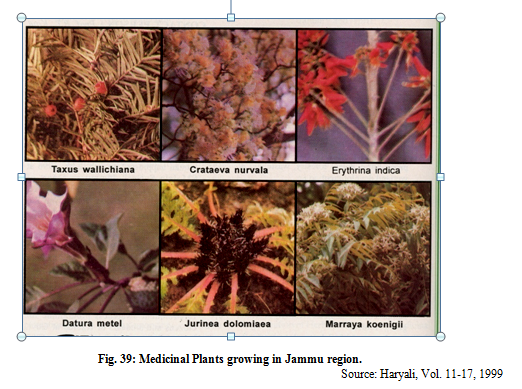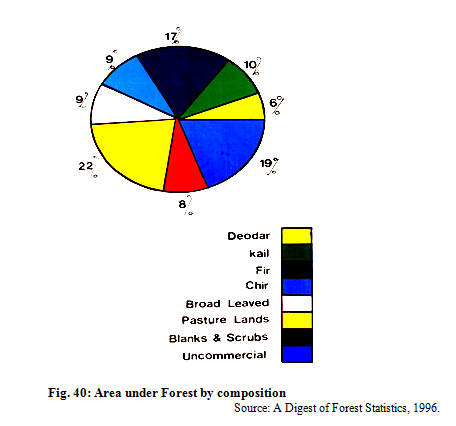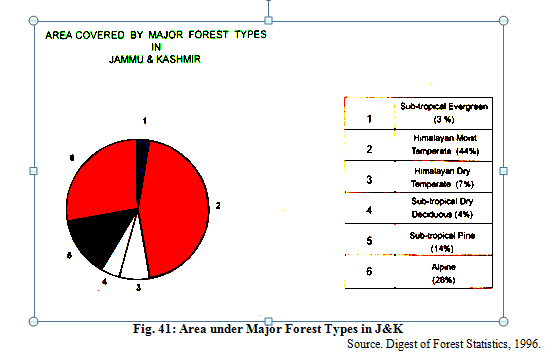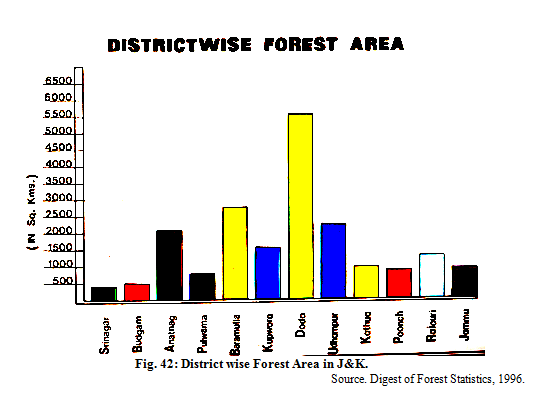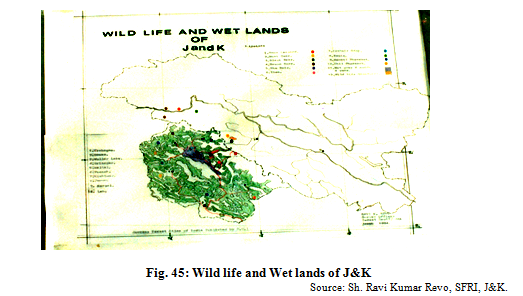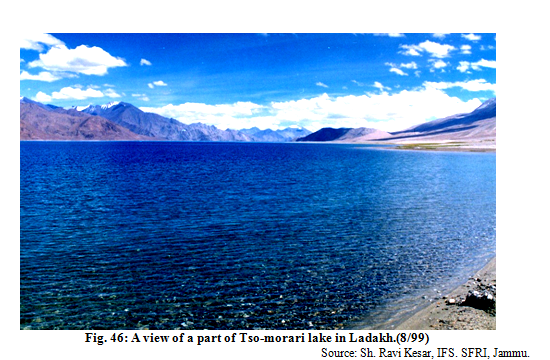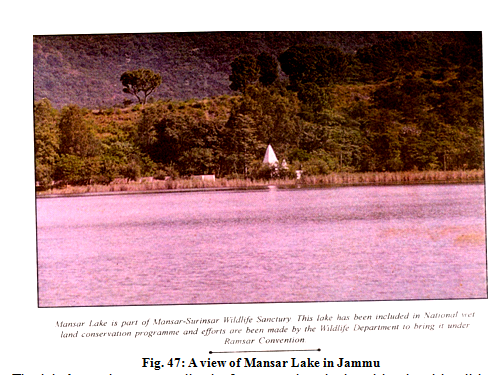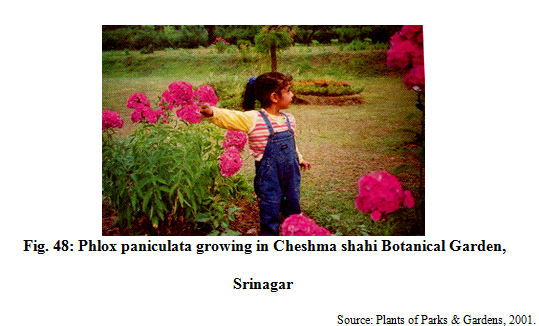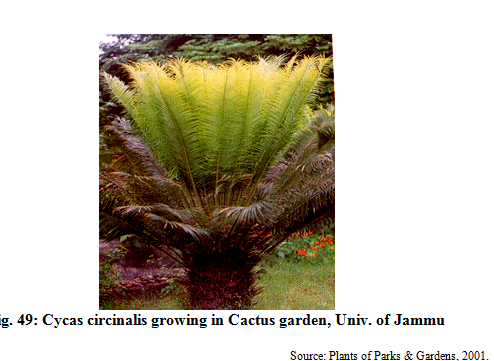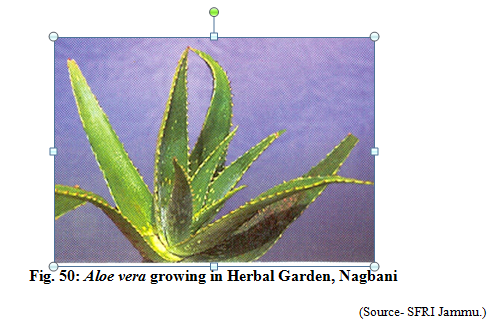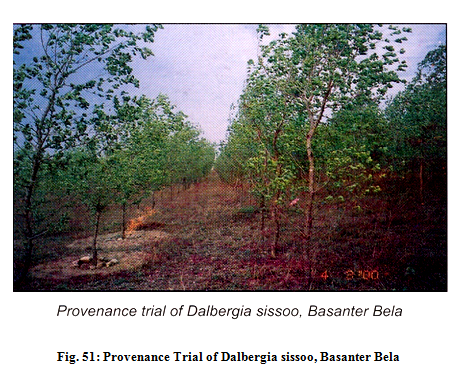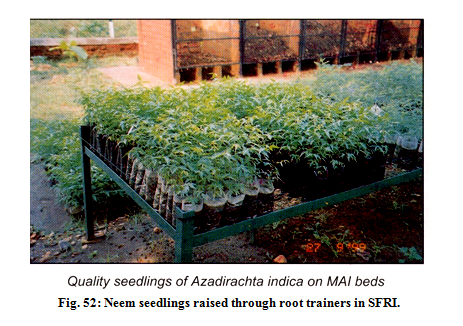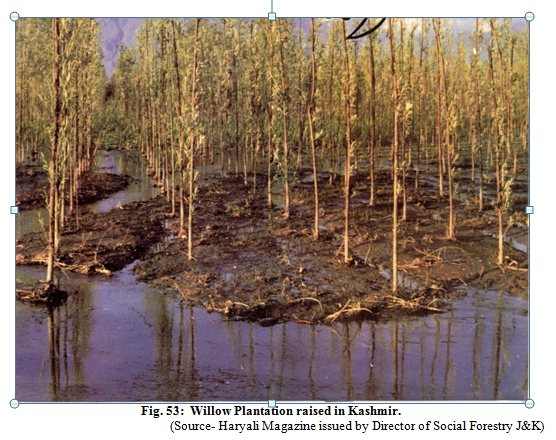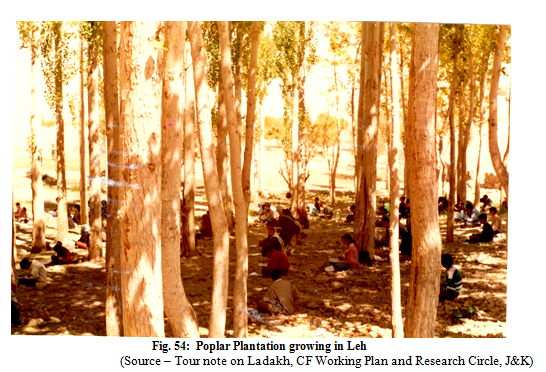Bio-diversity In Jammu, Kashmir, Ladakh: Ecological Profile
This article has been sourced from an authoritative, official readers who wish to update or add further details can do so on a ‘Part II’ of this article. |
Contents |
The source of this article
Bio-diversity in Jammu, Kashmir, Ladakh
By the Department of Forests, Government of Jammu and Kashmir
Cropland ecosystem
Agriculture and allied activities constitute the main occupation of people living in Jammu & Kashmir. About 60% of the population is directly or indirectly dependent on Cropland Ecosystem. The state reflects uniqueness in terms of hill and valley area agriculture, aquaculture, horticulture, sheep rearing and animal husbandry, carpet weaving, embroidery and handicrafts. Agriculture and animal husbandry including sheep rearing is practiced from the sub-tropical belt of Jammu to the cold-desert zone of Ladakh. The area under crop cultivation in the state is about 9.7 lakh hectares and the pastureland extends to 1.3 lakh hectares. The Kashmir region is a large valley with natural springs, streams, lakes, pastures and orchards. Here cultivation and domestication of various plant and animal varieties is unique. Many of the forms are peculiar to the region and are world famous.
The main agricultural crops of J&K are paddy, maize, wheat, oil seeds, pulses, vegetables and fruits. Paddy and maize are the two major kharif crops, whereas wheat and oilseed are major rabi crops. Total area under paddy cultivation has increased from 2,65,000 ha in 1985 to over 2,75,000 ha. Important rice growing areas are Anantnag, R.S. Pura and Bhaderwah. The oilseeds include Mustard, Sesame, Linseed and Alsi. Total area under oil seeds in the state was 64000 hectares in 1994-95 which got increased to 75000 ha in 1999-2000. The pulses grown in the state are Urd, Moong, Raungi, Rajmash and Kulth. The area under pulses was 55000 ha in 1968-69 but was decreased to 29000 ha. in 1999-2000.
Horticulture and Animal husbandry are other important allied activities of the agricultural sector and are very important to the Economy of J&K. Major fruits cultivated in J&K are Apple, Apricot, Cherry, Walnut, Quince, Amlook, Peach, Plum and Citrus. In the animal husbandry sector, Cows, Buffaloes, Goats, Sheep, Camels, Pigs, Poultry and Yak are domesticated.
In Jammu division wild stocks of various cultivars like Ber, Kainth, Amla, Peach, Olive, etc. are found growing. Keeping in view the economical importance of these cultivals efforts are already going on for utilizing these stocks for further improvement in the Horticulture sector. In order to boost the fruit industry in Jammu province, the cultivation of various fruit cultivars on modern and scientific lines is already in progress. The fruits under cultivation are Mango, Guava, Grapes, Litchi, Citrus, Walnut, Almond, Apple, Peach, Plum, Apricot and Peacannut. In addition to these, cultivars of Strawberry, Olive and Kiwi are also gaining popularity. Under area expansion programme department of Horticulture has covered an area of 2,19,039 ha. in respect of dry and fresh fruits by the end of 2000-01. The major cultivars grown in sub-tropical region of Jammu, Udhampur, Kathua and Rajouri are :
1) Ber Cultivars : Umaran, Samar No. 2, Katheli.
2) Mango Cultivars : Dusheri-51, Amarpali, Langra, Malda, Ratna.
3) Citrus Cultivars : Kinnow, Malta, Mausami, Sangtra, Sweetlime, Kagzi lime
Eurica lemon, Galgal, Kimb.
4) Lichi Cultivars : Dehradun, Calcuttia, Seed less.
5) Guava Cultivars : Lalit, Allahbad Safeda, L-49.
In temperate zone of Jammu province following cultivars of fruits are under cultivation: 1) Grape cultivars : Loose, Perlette, Thomson seedless, Shashi, Beauty
seedless.
2) Walnut cultivars : Medium shelled and Thin shelled.
3) Apple cultivars : Delicious, Ambri, Kesri, Maharaji,
4) Pear cultivars : Baghugosha, Nakh.
5) Peach cultivars : Shan-e-Punjab, Florda-sun, Sharbati,
6) Plum cultivars : Frontier, William, Santarosa,
7) Appricot cultivars : Webcom, Harkat, Amba
8) Pecannut cultivars : Mohan, Nalif.
9) Strawberry cultivar : Chandler, Duglas, Confutura.
10) Olive cultivar : European olive.
11) Kiwi cultivars : Allison, Abbott, Bruno, Hayward
The popularity of Kashmiri Apple, Walnut and Almond is growing all over the country. The snow kissed apple grown in valley is famous. Ambri cultivar is indigenous and is grown in South-Kashmir particularly in Shopian belt. The most promising varieties of pear grown in Kashmir are Sandy pear (Kashmiri Nakh), William pear (Baghugosha). The other indigenous varieties found in Kashmir are Kotar Nakh, Khar Paddar and Zirhami Pear (growing in Ganderbal). Grape varieties growing in Northern-Kashmir are Raipora and Lar in Ganderbal tehsil. Some indigenous varieties are Hussaini and Sahibi which are resistant to powedry mildews and downy mildews,
Sericulture is another allied activity which has developed over the years and now cocoon production has reached a new high of 8900 qtls. which was merely 3000 qtls in 1974-75. Number of sericulture villages is 2166 in the state. Production of raw silk is 21000 kgs. having a value of Rs. 2,60,000 lacs
Microlevel characteristics of agricultural landscape vary from place to place and due to these variations, different soils are able to support a wide range of plant and animal varieties. The Suru valley of Ladakh is watered by streams from the surrounding lofty mountain peaks and produce rich crops of wheat and barley. Traditionally, it has been an area surplus in food grains. Due to availability of water for irrigation, this area stands out in the otherwise desolate and barren landscape of Ladakh. There are good stands of willow and poplar and provide the landscape a lush green look which is rare in Ladakh. Down the river Indus, between Khaltse and Shyok Indus confluence, Drokpa community inhabits Dah & Biama villages. They grow various kinds of fruits like apricots, apples, walnuts and grapes. Cultivation of winter cherry is unique to the area. Red colored fruits of this plant are employed to decorate the head-dress. The ground floor in the suru-valley is covered with dense thickets of Sea-buckthorn which the locals use for fuel and fence purposes.
In the Nubra valley, down the river Shyok, to Hundar, a small population of Double-Humped Bactrian camels is found existing. In the olden days, they were introduced through the famous silk route as pack animals. During the past 50-60 years, they have been employed for the transportation purposes in the Nubra Valley. The valley is lush green along the water courses Major ground cover is formed by the Seabuck thorn, Myricaria, Lycium and Lonicera.
The Payong-gong lake is a unique water body which provides a spectacular view to the tourists. Reflections of the surrounding mountain peaks in the blues and greens of lake’s brackish water is a spectacle to be admired by all. Near this lake a scanty population of Chan-Panomads is seen. They cultivate peas, barleys in summer and during winter they unfold their tents (rebo) and take their flock of Sheep and pashmina goats out in the distant pastures. In Rupshu area, Korzok village situated at 4572 m above sea level forms the only permanent settlement. The local nomads called Chang-pa live in tents all the year round and move between pastures existing near snow melt streams. Few barley fields at Karzok are among the highest cultivated areas in the world but due to inhospitable climate, there is no guarantee that crop will ripen each year. Rupshu valley supports a sparse population of Wild Ass locally known by the name, Kyang. Various alpine lakes are breeding grounds for various birds like barheaded goose, Great Crested Grebe, Black necked cranes, Brahminy Duck and Brown Headed Gull.
The valley of Kashmir is famous for its fruit orchards and saffron cultivation. Fruit growing and saffron cultivation provides employment to more than 5 lakh families.
The climate is of Mediterranean type which is more suited to cultivation of different horticultural crops. Besides 90 private Nurseries, state Government has also established a good network of nurseries to provide the quality saplings to the fruit growers. More than 2000 sq. km. Area is under Fruit orchards. The annual production of fruits is tabulated as under:
Table 19: The District wise production of main fruits in Jammu & Kashmir for the year 1999-2000.
Department of Horticulture (Production in Metric Tonnes)
|
S. No |
Kind of fruit |
Srinagar |
Budgam |
Baramulla |
Kupwara |
Anantnag |
Pulwama |
Total |
Leh |
Kargil |
Total |
Jammu |
Kathua |
Poonch |
Rajouri |
Doda |
Udha-mpur |
Total |
Total |
|||||||||||||||||||||||||||||||||||||||||||||||||||||||||||||||||||||||||||||||||||||||||||||||||||||||||||||||||||||||||||||||||||
FRESH FRUITS |
|
|
|
|
|
|
|
|
|
|
|
|
|
|
|
|
|
|||||||||||||||||||||||||||||||||||||||||||||||||||||||||||||||||||||||||||||||||||||||||||||||||||||||||||||||||||||||||||||||||||||
|
1. |
Apple |
25506 |
39943 |
522091 |
69219 |
158397 |
100707 |
915863 |
3238 |
294 |
3532 |
0 |
1100 |
3815 |
288 |
2251 |
2173 |
9627 |
929022 |
|||||||||||||||||||||||||||||||||||||||||||||||||||||||||||||||||||||||||||||||||||||||||||||||||||||||||||||||||||||||||||||||||||
|
2. |
Pear |
2461 |
3592 |
2051 |
3304 |
2732 |
2345 |
16485 |
6 |
4 |
10 |
0 |
2500 |
6750 |
1050 |
1144 |
1302 |
12746 |
29241 |
|||||||||||||||||||||||||||||||||||||||||||||||||||||||||||||||||||||||||||||||||||||||||||||||||||||||||||||||||||||||||||||||||||
|
3. |
Apricot |
268 |
213 |
1056 |
45 |
233 |
250 |
2065 |
2541 |
1153 |
3694 |
0 |
40 |
30 |
55 |
561 |
159 |
845 |
6604 |
|||||||||||||||||||||||||||||||||||||||||||||||||||||||||||||||||||||||||||||||||||||||||||||||||||||||||||||||||||||||||||||||||||
|
4. |
Peach |
95 |
20 |
107 |
51 |
57 |
9 |
339 |
6 |
3 |
9 |
28 |
350 |
415 |
88 |
29 |
181 |
1091 |
1439 |
|||||||||||||||||||||||||||||||||||||||||||||||||||||||||||||||||||||||||||||||||||||||||||||||||||||||||||||||||||||||||||||||||||
|
5. |
Plum |
1028 |
482 |
0 |
62 |
209 |
198 |
1979 |
0 |
0 |
0 |
0 |
65 |
1556 |
120 |
32 |
104 |
1877 |
3856 |
|||||||||||||||||||||||||||||||||||||||||||||||||||||||||||||||||||||||||||||||||||||||||||||||||||||||||||||||||||||||||||||||||||
|
6. |
Cherry |
3170 |
152 |
481 |
368 |
419 |
714 |
5304 |
0 |
9 |
9 |
0 |
0 |
0 |
0 |
2 |
1 |
3 |
5316 |
|||||||||||||||||||||||||||||||||||||||||||||||||||||||||||||||||||||||||||||||||||||||||||||||||||||||||||||||||||||||||||||||||||
|
7. |
Mango |
0 |
0 |
0 |
0 |
0 |
0 |
0 |
0 |
0 |
0 |
5582 |
3140 |
0 |
908 |
0 |
921 |
10551 |
10551 |
|||||||||||||||||||||||||||||||||||||||||||||||||||||||||||||||||||||||||||||||||||||||||||||||||||||||||||||||||||||||||||||||||||
|
8. |
Ber |
0 |
0 |
0 |
0 |
0 |
|
0 |
0 |
0 |
0 |
8010 |
21 |
0 |
600 |
0 |
341 |
8972 |
8972 |
|||||||||||||||||||||||||||||||||||||||||||||||||||||||||||||||||||||||||||||||||||||||||||||||||||||||||||||||||||||||||||||||||||
|
9. |
Grapes |
1234 |
5 |
22 |
0 |
0 |
0 |
1261 |
8 |
3 |
11 |
178 |
5 |
1 |
0 |
0 |
19 |
203 |
1475 |
|||||||||||||||||||||||||||||||||||||||||||||||||||||||||||||||||||||||||||||||||||||||||||||||||||||||||||||||||||||||||||||||||||
|
10. |
Citrus |
0 |
0 |
0 |
0 |
0 |
0 |
0 |
0 |
0 |
0 |
3843 |
5283 |
153 |
1240 |
142 |
2635 |
13296 |
13296 |
|||||||||||||||||||||||||||||||||||||||||||||||||||||||||||||||||||||||||||||||||||||||||||||||||||||||||||||||||||||||||||||||||||
|
11. |
Olive |
0 |
0 |
0 |
0 |
0 |
0 |
0 |
0 |
0 |
0 |
0 |
0 |
0 |
0 |
1 |
1 |
2 |
2 |
|||||||||||||||||||||||||||||||||||||||||||||||||||||||||||||||||||||||||||||||||||||||||||||||||||||||||||||||||||||||||||||||||||
|
12. |
Other fresh |
1001 |
62 |
1354 |
524 |
47 |
0 |
2988 |
0 |
0 |
0 |
3916 |
678 |
306 |
1042 |
190 |
2112 |
8244 |
11232 |
|||||||||||||||||||||||||||||||||||||||||||||||||||||||||||||||||||||||||||||||||||||||||||||||||||||||||||||||||||||||||||||||||||
|
Total fresh |
34763 |
44469 |
527162 |
73573 |
162094 |
104223 |
946284 |
5799 |
1466 |
7265 |
21557 |
13182 |
13026 |
5391 |
4352 |
9949 |
67457 |
1021006 |
||||||||||||||||||||||||||||||||||||||||||||||||||||||||||||||||||||||||||||||||||||||||||||||||||||||||||||||||||||||||||||||||||||
DRY FRUITS |
|
|
|
|
|
|
|
|
|
|
|
|
|
|
|
|
|
|||||||||||||||||||||||||||||||||||||||||||||||||||||||||||||||||||||||||||||||||||||||||||||||||||||||||||||||||||||||||||||||||||||
|
1. |
Walnut |
1994 |
6071 |
7479 |
5473 |
22869 |
13722 |
57608 |
101 |
10 |
111 |
0 |
4000 |
5730 |
900 |
4061 |
2496 |
17187 |
74906 |
|||||||||||||||||||||||||||||||||||||||||||||||||||||||||||||||||||||||||||||||||||||||||||||||||||||||||||||||||||||||||||||||||||
|
2. |
Almond |
141 |
1909 |
9 |
0 |
124 |
7480 |
9663 |
1 |
0 |
1 |
0 |
1 |
0 |
1 |
2 |
4 |
8 |
9672 |
|||||||||||||||||||||||||||||||||||||||||||||||||||||||||||||||||||||||||||||||||||||||||||||||||||||||||||||||||||||||||||||||||||
|
3. |
Other dry |
144 |
0 |
0 |
0 |
0 |
0 |
144 |
0 |
0 |
0 |
0 |
0 |
2 |
41 |
0 |
2 |
45 |
189 |
|||||||||||||||||||||||||||||||||||||||||||||||||||||||||||||||||||||||||||||||||||||||||||||||||||||||||||||||||||||||||||||||||||
|
Total dry |
2279 |
7980 |
7488 |
5473 |
22993 |
21202 |
67415 |
102 |
10 |
112 |
0 |
4001 |
5732 |
942 |
4063 |
2502 |
17240 |
84767 |
||||||||||||||||||||||||||||||||||||||||||||||||||||||||||||||||||||||||||||||||||||||||||||||||||||||||||||||||||||||||||||||||||||
|
Grand Total |
37042 |
52449 |
534650 |
79046 |
185087 |
125425 |
1013699 |
5901 |
1476 |
7377 |
21557 |
17183 |
||||||||||||||||||||||||||||||||||||||||||||||||||||||||||||||||||||||||||||||||||||||||||||||||||||||||||||||||||||||||||||||||||||||||||
|
District |
Rice |
Maize |
Wheat |
Pulses |
Oilseeds |
|||||
|
Area (000ha) |
Prod. (000 qtsl) |
Area (000ha) |
Prod. (000 qtsl) |
Area (000ha) |
Prod. (000 qtsl) |
Area (000ha) |
Prod. (000 qtsl) |
Area (000ha) |
Prod. (000 qtls) |
|
|
Anantnag |
37.58 |
2278 |
25.69 |
1020 |
- |
16 |
1.15 |
53 |
24.06 |
- |
|
Pulwama |
23.33 |
11.58 |
0.53 |
1.69 |
19.42 |
|||||
|
Srinagar |
12.02 |
4.70 |
- |
0.62 |
2.23 |
|||||
|
Budgam |
24.91 |
16.32 |
0.42 |
0.85 |
5.39 |
|||||
|
Baramulla |
27.19 |
32.44 |
0.47 |
4.71 |
3.26 |
|||||
|
Kupwara |
11.25 |
24.10 |
0.13 |
1.78 |
2.58 |
|||||
|
Leh |
- |
- |
- |
- |
2.55 |
36 |
0.26 |
6 |
0.07 |
- |
|
Kargil |
- |
- |
1.61 |
0.64 |
- |
|||||
|
Jammu |
50.16 |
1875 |
20.99 |
4238 |
101.05 |
1435 |
5.91 |
69 |
2.78 |
- |
|
Udhampur |
9.80 |
57.70 |
41.55 |
2.48 |
2.58 |
|||||
|
Doda |
3.50 |
51.73 |
11.09 |
2.88 |
2.76 |
|||||
|
Kathua |
34.30 |
16.23 |
53.10 |
3.64 |
7.08 |
|||||
|
Rajouri |
6.42 |
45.05 |
53.83 |
0.77 |
0.36 |
|||||
|
Poonch |
3.60 |
23.68 |
14.63 |
0.07 |
1.34 |
|||||
|
Total |
244.05 |
4153 |
330.21 |
5258 |
280.96 |
1487 |
27.45 |
128 |
73.91 |
281.61 |
Source: Digest of Statistics.
18758
6333
8415
12451
84697
1105773
Source : Directorate
Rice is the major crop of the farmers and is grown over 250000 ha. Various local rice varieties like Mushkbujhee, Larbol, Nunabol, Londa, etc. are unique to this region of Kashmir. Out of annual rice production of 41,53,000 qtls. in the state, 22,78,000 qtls. is supplied by the Kashmir farmers alone (2000-01 data).
Jammu province has sub-tropical type of climate in the Kandi belt of Kathua and Jammu districts. People usually grow wheat, maize and millets in this area. Other crops grown are Rajmash, Pulses, Vegetables, Mustard, Sesame, Linseed, etc. The Command Area Development has been instrumental in changing the agricultural economy of the people by providing them the facilities of irrigation, fertilizers, improved hybrid seeds,
Table 20: Production of various crops in Command Area of Jammu
|
Crop |
1975-76 Produc-tivity Qtls. |
Prod. M.T. |
1993-94 Produc-tivity |
Prod. M.T. |
1995-96 Produc-tivity |
Prod. M.T. |
1996-97 Produc-tivity |
Prod. M.T. |
1997-98 Produc-tivity |
Prod. M.T. |
1998-99 Produc-tivity |
Prod. M.T. |
|
Paddy |
12 |
11400 |
45 |
90154 |
45 |
96750 |
38.50 |
84700 |
39.20 |
88317 |
39.20 |
86455 |
|
Maize |
15 |
31500 |
20 |
27805 |
25 |
28000 |
27.80 |
27800 |
24.00 |
26082 |
24.00 |
26250 |
|
Oil seeds |
04 |
9200 |
26 |
14868 |
08 |
16760 |
08.00 |
9176 |
08.10 |
10368 |
08.10 |
9834 |
|
Pulses |
|
|
|
|
|
|
08.00 |
7328 |
07.00 |
6650 |
07.00 |
6823 |
|
Wheat |
10 |
40000 |
33 |
144000 |
33 |
144500 |
32.00 |
152032 |
33.60 |
178712 |
35.60 |
181916 |
|
|
|
92100 |
|
276817 |
|
287010 |
|
281036 |
|
310099 |
|
311278 |
Source: Digest of Statistics.
In the Chenab valley of Doda district monsoon is poor and deficient in Doda and Kishtwar whereas Bhaderwah is comparatively moist. Major crops grown in this valley are Maize, Rice, Rajmash, etc.
In the Poonch District Gujjars and Bakerwals reside on the mountain slopes. They have small land holdings and most of them rear herds of sheep and goats. Maize, wheat and paddy are the principal crops in this region.
Forest Ecosystem
Forests of J&K extend over an area of 20182 sq. km. out of total geographical area of 222236 sq. km. The Total Forest Cover works out to be about 9%. As per National Forest Policy, 1988, J&K being the Hilly state, the forest cover of 66% is required against the prescription of 33% for plain region of the states. Whatever forests are existing, their density is also variable, about 46% of the forest cover has density between 10-40% and only the remaining forest cover has density of more than 40%.
Fig. 34: Forest Cover in J&K Source: Digest of Forest Statistics, 1996, J&K Government.
Singh & Kachroo, 1976, have identified three main vegetation types in the state: 1. Alpine desert vegetation of Ladakh.
2. Temperate vegetation of Kashmir.
3. Sub-tropical vegetation of Ladakh.
Alpine Desert Vegetation of Ladakh
Ladakh, the land of Lamas and Gompas is a trans-Himalayan high altitude cold desert with very rough physiography and wide open valleys along the rivers. The region is devoid of bryophytes and pteridophytes and even natural trees are absent. Due to scarcity of rainfall, plants are generally restricted to the river banks, moist rock surfaces and other sheltered habitats. According to Stewart, 1916, Ladakh flora has three main components, i.e. Alpine, Desertic and Oastic.
The Alpine flora is found existing along the edges of melting glaciers at an elevation exceeding 3300 m. Major plants of this component include Pedicularis, Delphiniums, Primulas, Gentianas, Lomantogonium, Saussureas, Arnebias, Rheums, etc.
The Desertic type of flora is characteristic of Ladakh and it shows distinct affinities with the plants of Tibet and Siberia. The plant forms are mostly stunted. Xerophytic and cushion like, as an adaptation to cold dry winds and blizzards. Common plant species are Caragana brevifolia, Acantholimon lycopodioides, Arenaria festucoides, Thylocospermum caespitosum, etc.
The Oasitic type of elements are restricted to mesophytic type of places. Common plants of this category comprise of Junipers, Acer, Populus, Salix, Prunus, Polygonums, Primulas, Anemones, etc.
Temperate Vegetation of Kashmir
Kashmir valley is drained by the river Jhelum and numerous snow-fed tributaries from the surrounding mountains. Many springs and streams add to the charm and beauty of flowers. The water courses and margins of streams support the luxuriant vegetation comprising of plants like Spiraeas, Impatiens, Chenopodiums, Epilobiums, Geraniums, Delphiniums, Ranunculus, Fragaria, Primulas, Polygonums, Fritillarias, Potentillas and Pedicularis species. Vegetation of lakes comprise of Lythrum salicaria, Nymphaeas, Nelumbo Trapa, Limnanthemum, Hydrillas, Utricularias, Ceratophyllum, Typhas and other grasses.
Natural vegetation stands altered by the introduction of many exotics like Poplars, Willows, Chinars, Spanish chest nut, Magnolias, Acer negonda, Ailanthus, Albizia julibrissin, Buddlejas, Hydrangeas, Philadelphus, Hypericums, Spiraeas, Phlox paniculata, Viburnum opulus and cherry laurels. Euryala ferox once common in Dal lake is seldom seen in the water bodies of Kashmir.
Dominant tree flora is composed of Pinus wallichiana, Cedrus deodara, Picea smithiana, Taxus wallichiana, Abies pindrow, Aesculus indica, Acer pictum, Parrotiopsis jacquemontiana, Carategus soongarica, Lonicera in the blue pine zone and higher up species like Salix denticulate, Skimmia laureola, Lonicera myrtilis, Berberis jaeschkeana are frequently found. Towards the upper limit, Abies pindrow, Betula utilis, Rhododendron campanulatum, Cotoneaster, Viburnum and Lonicera species form the major component of the Flora.
Alpine vegetation is comprised of elements like Aconitums, Delphiniums, Primulas, Anemones, Aquilegias, Asters, Saussureas, Corydalis, Potentillas and Pedicularis species which add colour and beauty to the summer landscape of the Kashmir mountains and meadows. Various kinds of Apollo butterflies are also a common sight. Various kinds of Nival insects alone find shelter in this zone.
Sub-tropical Vegetation of Jammu
Dry mixed deciduous type of vegetation is the major component of Flora of Jammu. The area supports three types of vegetations i.e. Scrub forests in the semi-arid tract; scrub and mixed deciduous vegetation at higher elevations and temperate vegetation in the higher hills.
Directorate of Social Forestry J&K
Scrub forests are typically dominated by plants like Acacia modesta, Dodonea viscosa, Justicia adhatoda, Caralluma tuberculata, Telosma pallida, Tribulus terrestris, Cassia occidentalis, Tephrosia purpurea, Ziziphus mauritiana, Capparis sepiaria, Woodfordia fruiticosa, Butea monosperma, Cassia fistula, Dioscorea belophylla, Delbergia sissoo, Caeseria tomentosa, Putranajiva roxburghii, etc.
Mixed deciduous vegetation of higher elevations is formed by the presence of Flacaurtia indica, Lannea coromandelica, Mallotus phillipensis, Ehretia laevis, Holarrhaena antidysentrica, Moringa oleifera, Emblica officinalis, Acacia nilotica, Ficus racemosa, Premna mucronata, Ougeinia oogeinensis, Maytenus royleanus, Terminalia bellerica, Bauhinia variegata, Bombax ceiba, Aegle marmelos, Hymenodictyon excelsum and Elaeodendron glaucum.Hill vegetation is dominated by plants like Wendlandia heynei, Grewia optiva, Pistacia integerrima, Lannea coromandelica, Pinus roxburghii, Reinwardtia indica, Oroxylum indicum, Eranthemum pulchellum, Caesalpinia decapetala, Antidesma diandrum, Mallotus phillipensis, Buddleja asiatica, Ficus roxburghii, Pyrus pashia, Rhamnus triqueter, Rubus ellipticus.
Still higher elevations in the chenab valley and Rajouri – Poonch Districts support plants like Quercus ilex, Quercus dilatata, Quercus glauca, Quercus semicarpifolia, Quercus leucotrichophora, Acer pictum, Lyonia ovalifolia, Rhododendron arboreum, Andrachne cordifolia, Fraxinus hookeriana, Machilus odoratissima, Litsea chinensis, Neolitsea pallens, Morus serrata, Ulmus villosa, Desmodium tilaefolium, Dabregeasia hypoleuca, Berberis lycium, Buddleja crispa, Indigofera gerardiana, Ehretia serrata, Symplocos paniculata, Rhus punjabensis, Prinsepia utilis, Lonicera quinquelocularis etc. Ground Flora is comprised of herbaceous plants like Boenninghausenia albiflora, Polygala crotalarioides, Sarcococa saligna, Ranunculus lactus, Potentilla nepalensis, Geum urbanum, Salvia lanata, Stachys, Prunella vulgaris, Bistorta amplexicaulis, Onychium japonicum, Pteris longifolia, Polystichum aculeatum, Mosses and lichens.
Forest Types
Mainly 8 types of forests are identified in Jammu and Kashmir These are described below:
i)Tropical dry deciduous forests: These occur in sub-tropical belt of Jammu & extend to some of inner valley of outer Himalayan zone Anogeissus latifolia is found only in Reasi forest Division and Dendrocalamus is confined nto the Jasrota range in Kathua district. Acacia catechu is absent in Mendhar. Wendlandia heynei (Paansar) is found extensively in Jindrah, Reasi, Kalidhar, Udhampur & Dhaleri ranges. Acacia modesta (Phulai) is also found in this region. Along Ujh river near Mandli, Euphorbia is growing in abundance. It has 3 sub-types:
a) 5B/C2 – Troppical dry deciduous forest
b) 5B/DS1 – Dry deciduous scrub
c) 5/E9 – Dry bamboobrakes
ii) Sub-tropical Pine Forests: These forests occur on the steep dry slopes below 1000 m on the Shivalik hills under varying conditions of climate. These forests are found in Jammu, parts of Udhampur, Billawar, Reasi and Poonch Forest Divisions where Summer temperatures are high but snow falls in winter months. These forests are of 4 sub-types;
a) 9/C1/a – Lower or Shivalik Chir Pine forests.
b) 9/C1/b – Upper or Himalayan Chir Pine forest
c) 9/C1/DS1 – Himalayan sub-tropical scrub
iii) Sub-tropical Dry evergreen forests: These forests are dominated by evergreen species and include thorny shrubs. This type is confined to areas where hot season prevails for a long period of time and remains dry and winter experience cold with forest. These forests thrive better on sedimentary rocks, sandstones and limestones and hilly grounds where soil is shallow and dry. This type is further divided into 3 sub-types.
a) 10/C1/a – Olea cuspidata scrub forest.
b) 10/C1/b – Acacia modesta scrub forest
c) 10/C1/DS1 – Dodonaea scrub.
First sub-type occurs widely in Poonch, Rajouri, Ramban, Reasi and Udhampur forest Divisions, 2nd sub-type exists in and around Jammu Forest Division and 3rd sub-type is found in Kishanpur, Jhajjar Kotli, Mansar-Manwal, Jindrah & Kalidhar areas.
iv) Himalayan moist-temperate Forests: These forests are of conifers and are found between sub-tropical pine forests and sub-alpine formation throughout the Himalayas. These are of following types:
a) 12/C1/a – Ban Oak forest
b) 12/C1/\b – Moru Oak forest
c) 12/C1/c - Moist Deodar forest
d) 12/C1/d – Western mixed conifer forest
e) 12/C1/e – Moist temperate deciduous forest
f) 12/C1/f – Low level blue pine forest
g) 12/C1/DS1 – Oak scrub
h) 12/Ci/DS2 – Himalayan secondary scrub
i) 12/C2 – Upper west Himalayan temperate forest
j) 12/C2/a – Kharshoo Oak forest (Quereus semecarpifolia)
k) 12/C2/b – West Himalayn Oak fir forest
l) 12/C2/c – Moist temperate deciduous forest.
m) 12/DS2 – Himalayan temperate parkland
n) 12/DS3 – Himalayan temperate pastures
o) 12/IS1 – Alder forest
p) 12/2S1 – Low level blue pine forest
v) Himalayan Dry temperate Forests: These forests are confined to the inner valleys of the Himalayas where snowfall is a permanent feature. These forests generally exist in open form but occasionally they show a closed canopy under ideal conditions of growth. These forests are of following 11 sub-types:
a) 13/C1 – Dry broad leaved and coniferous forest
b) 13/C2 – Dry temperate coniferous forest
c) 13/C2/a – Neoza pine (Pinus gerardiana)
d) 13/C2/b – Dry deodar forest
e) 13/C2/Dsi – Pohu scrub (Parrotiopris jacquemontiana)
f) 13/C2/DS2 – Dry temperate scrub
g) 13/C3 – West Himalayan Dry temperate deciduous forest
h) 13/C4 – West Himalayan high level dry blue pine
i) 13/C5 – West Himalayan dry Juniper forest
j) 13/1S1 – Hippophae – Myricaria scrub
k) 13/1S2 – Populus – salix forest
vi) Sub-alpine forests: These forests are basically dominated by fir, birch & rhododendron trees. These forests are of following 2 sub-types
a) 14/C2/a – West Himalayan sub-alpine high level fir forest
b) 14/C1/b – West Himalayan Birch/fir forest.
vii) Moist alpine scrub: These are of 5 sub types:
a) 15/C1 – Birch-Rhododendron scrub forest
b) 15/C2 – Deciduous Alpine scrub
c) 15/C2/E1 – Dwarf Rhododendron
d) 15/E2 – Juniper scrub
e) 15/C3 – Alpine Pastures
viii) Dry Alpine scrub : These are of 2 sub-types:
a) 16/C1 – Dry Alpine scrub
b) 16/E1 – Dwarf juniper scrub.
The area under various forest types in J&K is shown in the table below:
|
S.No. |
Forest Types |
Area in Sq. Kms. |
|
1. |
Tropical dry Deciduous Forests |
830 |
|
2. |
Sub tropical pine Forests |
2810 |
|
3. |
Sub tropical dry evergreen forests |
710 |
|
4. |
Himalayan moist temperate forests |
9170 |
|
5. |
Himalayan dry temperate forests |
1410 |
|
6. |
Sub-alpine/Sub-moist alpine, Sub-dry alpine scrub |
5880 |
|
Total |
20810 |
|
Sites of In-situ Conservation
As per article 2 of contention on Biodiversity term, ‘In-situ Conservation’ means the conservation of ecosystems and natural habitats and the maintenance and recovery of viable populations of species in their natural surroundings and in the case of domesticated or cultivated species, in the surroundings where they have developed their distinctive properties.
Protected Area in J&K
Prior to 1978, there existed only 16 protected areas (PAs’) over an area of 516 sq. km. in the Kashmir Valley. Subsequently more areas were identified and declared as Protected Areas. At present Government of Jammu and Kashmir has declared 4 National parts, 14 Wildlife Sanctuaries, 19 Wildlife reserves and 16 Wetlands reserves. The area under these parks, sanctuaries, reserves and wetlands is 4680, 10298, 656 and 146 sq. km. respectively. The total notified area under all the protected areas works out to 7.10% of the total geographic area against the target of 15% fixed by the Central Government.
The Government of Jammu & Kashmir vide various SRO's, notifications and cabinet decisions issued from time to time till date has declared 4 National Parks, Fourteen Wildlife Sanctuaries, 19 Wildlife Reserves and 16 Wetland reserves covering an area of 4680.25; 10298.50; 656.75 and 146.25 sq. km. Respectively. Thus the total notified area under these protected areas network is approximately 15781.75 sq.km. which is about 7.10 % of the total geographic area. However, if the non-forest areas coming under high altitude cold desert and wetlands are taken into account under the protected area network which goes up to 11.40% (2398.50 sq. km. Area).
The area under PAN is still low as compared to the target of 15% fixed by the Government of India. If the actual area under the administrative control of the Department is taken into consideration, then out of 15781.75 sq. km., under 53 notified areas, only 15365.50 sq. km. Area under 40 protected areas is being managed by the Wildlife Department. This is due to the reason that some areas have been partially transferred to Department and the net forest land under these protected areas is only 2042.75 sq. km. which works out about 9% of the total forest area in the state.
Table 22: Region wise area under PAN in J&K
|
S.No. |
Region |
Area Notified (sq. km.) |
|
1. |
Jammu |
00861.50 |
|
2. |
Kashmir |
01690.25 |
|
3. |
Ladakh |
13230.00 |
|
|
Total |
15781.75 |
Table 23: Region wise list of National Parks, Sanctuaries and other Protected Areas in J&K
|
S.No. |
Name of the Region |
Protected Area |
Area in sq. km. |
|
1. |
Jammu |
<![if !supportLists]>1. <![endif]>Kishtwar National Park <![if !supportLists]>2. <![endif]>Ramnagar Wildlife Sanctuary <![if !supportLists]>3. <![endif]>Surinsar Mansar Wildlife Sanctuary <![if !supportLists]>4. <![endif]>Nandni Wildlife Sanctuary <![if !supportLists]>5. <![endif]>Trikuta Wildlife Sanctuary <![if !supportLists]>6. <![endif]>Jasrota Wildlife Sanctuary <![if !supportLists]>7. <![endif]>Sudh-Mahadev Wildlife Reserve <![if !supportLists]>8. <![endif]>Jawahar Tunnel Wildlife Reserve <![if !supportLists]>9. <![endif]>Thein Wildlife Reserve <![if !supportLists]>10. <![endif]>Bahu Wildlife Reserve <![if !supportLists]>11. <![endif]>Gharana Wetland Reserve <![if !supportLists]>12. <![endif]>Pargwal Wetland Reserve <![if !supportLists]>13. <![endif]>Kukrian Wetland Reserve <![if !supportLists]>14. <![endif]>Sangral Wetland Reserve <![if !supportLists]>15. <![endif]>Nanga Wetland Reserve Sub-Total |
400.00 12.75 55.50 44.25 27.75 25.75 142.25 18.00 19.00 19.75 0.75 49.25 24.25 7.00 15.25 0861.50 |
|
2. |
Kashmir |
<![if !supportLists]>1. <![endif]>Dachigam National Park <![if !supportLists]>2. <![endif]>Salim Ali National Park (City Forest) <![if !supportLists]>3. <![endif]>Overa Aru Wildlife Sanctuary <![if !supportLists]>4. <![endif]>Gulmarg Wildlife Sanctuary <![if !supportLists]>5. <![endif]>Lachipora Wildlife Sanctuary <![if !supportLists]>6. <![endif]>Hirpora Wildlife Sanctuary <![if !supportLists]>7. <![endif]>Baltal (Thajwas) Wildlife Sanctuary <![if !supportLists]>8. <![endif]>Limber Wildlife Sanctuary <![if !supportLists]>9. <![endif]>Rajparian (Daksum) Wildlife Sanctuary <![if !supportLists]>10. <![endif]>Dara/Khimber/Sharazbal Wildlife Reserve <![if !supportLists]>11. <![endif]>Brein Wildlife Reserve <![if !supportLists]>12. <![endif]>Khonmoh Wildlife Reserve <![if !supportLists]>13. <![endif]>Khrew Wildlife Reserve <![if !supportLists]>14. <![endif]>Khanagund Wildlife Reserve <![if !supportLists]>15. <![endif]>Panyer Wildlife Reserve <![if !supportLists]>16. <![endif]>Ajwas Wildlife Reserve <![if !supportLists]>17. <![endif]>Zaloora Harwan Wildlife Reserve <![if !supportLists]>18. <![endif]>Naganari Wildlife Reserve <![if !supportLists]>19. <![endif]>Shikargah Wildlife Reserve <![if !supportLists]>20. <![endif]>Khirram Wildlife Reserve <![if !supportLists]>21. <![endif]>Wangat (Chatergul) Wildlife Reserve <![if !supportLists]>22. <![endif]>Narkara Wetland Reserve <![if !supportLists]>23. <![endif]>Malgam Wetland Reserve <![if !supportLists]>24. <![endif]>Ajaz Wetland Reserve <![if !supportLists]>25. <![endif]>Hokera Wetland Reserve <![if !supportLists]>26. <![endif]>Hygam Wetland Reserve <![if !supportLists]>27. <![endif]>Shallabugh Wetland Reserve <![if !supportLists]>28. <![endif]>Chatlum-Pampore Wetland Reserve <![if !supportLists]>29. <![endif]>Manibugh Wetland Reserve <![if !supportLists]>30. <![endif]>Achhabal Wildlife Reserve Sub-Total |
171.25 9.00 511.00 139.25 93.50 114.50 210.50 43.75 20.00 34.00 15.75 67.00 50.25 15.00 10.00 48.00 25.25 22.25 15.50 15.75 12.00 3.25 4.50 1.00 13.75 7.25 16.00 0.25 0.25 0.50 1690.25 |
|
3. |
Ladakh |
<![if !supportLists]>1. <![endif]>Hemis National Park <![if !supportLists]>2. <![endif]>Karakoram (Nubra Shyok) Wildlife Sanctuary <![if !supportLists]>3. <![endif]>Changthang Wildlife Sanctuary <![if !supportLists]>4. <![endif]>Kanji Wildlife Reserve <![if !supportLists]>5. <![endif]>Sabu Chakore Reserve <![if !supportLists]>6. <![endif]>Bodhkharbu Chakore Reserve <![if !supportLists]>7. <![endif]>Noorichan Wetland Reserve <![if !supportLists]>8. <![endif]>Tsomorari Wetland Reserve Sub-Total |
4100.00 5000.00 4000.00 100.00 15.00 12.00 2.00 1.00 13230.00 |
Grand Total |
15781.75 |
||
Wetland ecosystem of Jammu & Kashmir
In the state of J&K, wetlands occupy an area of 218.8 sq. km. out of total geographical area of 222,236 sq. km. Most of these wetlands are natural and are grouped into 3 major categories, Valley lakes (1580-1600 m), Forest lakes (2000-2500 m) and Glacial lakes (3000 m). Valley lakes are found in Kashmir region, forest lakes are seen in Pir Panjal range and glacial lakes are seen in Ladakh region. The lakes occurring at low altitude (600 m) in the Lower Shivalik belt of Jammu come under the fourth category of Shivalik lakes. The valley lakes have been studied extensively for their biological and other related characteristics as compared to forest lakes and glacial lakes of other areas.
A. Valley lakes :
Hydrologically, these lakes are classified as drainage, semi-drainage and non-drainage types. Drainage type of lakes have distinct inflow and outflow channels and water retention is for a small period of few days e.g. Wular and Anchar lakes. In the semi-drainage type of lakes, water retention period lasts for few months e.g. Manasbal lake. In the non-drainage type, lakes have closed basin and water is retained for several years e.g. Bodsar and Trigam lakes.
1. Dal lake : This lake has been centre of attraction for the tourists from all over the World for many years and has remained as a hub of Kashmiri civilisation. It is post-glacial waterbody bounded by Srinagar city on the south-west and west side and by gentle terraced sloppy mountains on the other side.
This lake is situated at an altitude of 1587 m. having area reduced from 2100 ha in 1950 to 1060 ha in 1985. Its location on the map is 340-06´N and 740-45´E. It lies in the flood plain of the Jhelum river, whose course has cut swarmy lowlands out of the Karewa terraces. Telbal nalla channel joins the waterbody in the north and during its downward journey collects large quantities of deposits in it. A number of perenial water channels from the human settlements also discharge their sewage into the lake. Towards the south-west side an outflow channel, Tsunti Kol discharges lake water into the river Jhelum at Gawkadal. On its eastern side, nallah Amir Khan channel joins it with the Khushhal Sar lake near Zadibal which in turn is connected to Anchar lake.
A peculiar feature of Dal lake is presence of floating gardens which are centuries old. They are made of long strips of the reed stems moored at four corners by poles driven into the lake bed. Heaps of weed and mud are extracted from the lake to put on the secured strips at regular intervals in the form of cones commonly called as pokhar and in each cone, seedlings of vegetables are transplanted. Good quality vegetables are grown in lands adjacent to these floating gardens amidst willow and poplar groves. These floating gardens were compared by Lawrence (1895) with the Chinampas of Old Mexico and also resemble the ‘Phumdi’ of Loktak lake. These gardens with the passage of time, became laden with more and more heaps of weed and mud resulting into formation of islets called dembs which affects the lake ecosystem.
The lake water is alkaline with pH ranging from 7.5 to 9.8 with dominance of calcium bicarbonates. Total phosphorus and ammonical nitrogen concentration has increased tremendously over the last few decades and has added to the process of entrophication (Zutshi & Vass, 1971). The most common aquatic weeds of the Dal lake are Lythrum salicaria, Nelumbo nucifera, Nymphoides peltatum, Ceratophyllum demursum, Myriophyllum spicatum, Potamogeton lucens, P. pectinatus, Hydrilla verticillata, Euryale ferox (now almost extinct), Salvinia natans (water fern), Lemna minor etc.
Among phytoplanktonic life, Amphora, Cocconeis placentula, Cymbella ventricosa, Gomphonema olivaceusn, Navicula radiosa, Nitzschia acicularis, Fragilaria crotonensis, Synedra ulna, Cosmarium, Anacystis, Merismopedia and Euglena rubra are dominant.
Among zooplanktonic life, 44 species of Rotifers, 21 species of Cladocerans, 7 species of Copepods stands reported. Dominant rotifer taxa include Keratella cochlearis, Polyarthra vulgaris, Filinia longirostris, Brachionus angularis, Hexarthra sp., Anuraeopsis fissa, Monostyla bulla, Lepadella ovalis etc. Among Cladocerans, dominance is represented by taxa like Chydorus sphaericus, Bosmina longirostris, Moina micrura, Acroperus harpar, Graptoleberis testudunaria, Acantho diaptomus and Eucyclops speratus. Among Annelida, presence of Limnodrilus hoffmeisteri, Branchiura sowerbii is reported. Chironomus and Penteneura larvae are also found in large numbers in the benthic community. Lymnaea columella and Gyraulus parvus are common benthic molluses in the lake.
The fish fauna include two varieties of introduced common carp, Cyprinus carpio Communis and C. carpio specularis and native fish like Schizothorax niger, S. esocinus, S. curvifrons, S. micropogon, Labeo dera and Crossocheilus diplochilus. Rana cyanophlictes and Bufo viridis are common representatives of the class amphibia among tetrapoda. This lake is also the habitat of many resident and migratory birds represented by dabchick, pheasant tailed jacana, white spotted fantail, yellow wagtail, whiskered tern, little bittern, lapwing etc. Winter migrants are common teal, pintail duck, shovellar, mallard and brahminy duck. Otter, an aquatic mammal is also reported from this lake. Jackal, fox, mice are other mammalian representatives in the vicinity.
2. Wular lake : Wular lake is one of the largest freshwater wetland of Asia. It is located between north latitudes 340-16´ and 340-26´ and east longitudes 740-33´ and 740-42´ at an altitude of 1530 m. It occupied an area of about 20,200 ha. (Lawrence, 1895) in last century but the present expanse is not more than 2400 ha. It is about 35 km. from Srinagar city in the north-west direction.
The lake is surrounded by numerous villages like Ashtung, Malangam in the north, Qazipur, Bandipur, Lankreshpur in the north-east, Aaragam, Haungtung, Sudrakoot, Hajan, Shahgund in the east, Kanibathi in the north-west, Kiunnus, Watlab, Hatlung in the west and Sopore and Tarzu in the south.
Wular lake is largely shallow with a maximum depth of 5.8 m on the western side just opposite the hills of Baba Shuker Din. On its eastern and southern side are the low-lying areas of Sonawari which used to get innundated every year until a series of bunds were constructed to control the water. The land thus reclaimed was brought under agriculture and horticulture and thus the area of the lake got reduced.
The lake is fed by many streams and Jhelum is its main tributary which enters the lake on the eastern side at Banyar in Hajan block. Jhelum river has deposited lot of debris in the lake in the past. Alongwith this, other streams like Madhumati, Erin, Ningli and Watpora has also added their deposits into this lake. The Jhelum river forms the outlet at place called Ningli near Sopore on its southern side.
The lake water remains alkaline with pH > 7.5, carbonates and bicarbonates of calcium contributing towards the alkalinity. Due to fast reclaimation of land for the use of agriculture and horticulture, riverine deposits of Jhelum and other tributaries and large quantities of solid and liquid waste from the adjoining villages and towns, the lake has entered into a eutrophic state and the process of eutrophication has reached an alarming proportion which needs to be arrested.
Algal explorations in the lake have revealed the presence of 82 species and major genera are Navicula, Synedra, Amphora, Fragillaria, Scenedesmus, Pediastrum, Pandorina, Oedogonium, Oscillatoria, Anacystis, Anabaena, Spirulina, Euglena etc. Euglena rubra sometims forms red colour blooms in the lake. Among higher plants, taxa like Ceratophyllum demursum, Myriophyllum spicatum, Nymphoides peltatum, Trapa bispinosa, Lemna minor are commonly represented.
Zooplanktonic representatives in the lake are dominated by the Wheel animalcules (Rotifera) followed by Cladocerans and Copepods. Among rotifers, species found are Euchlanis dilatata, Keratella cochlearis, Filinia longiseta, Trichocerca sp., Brachionus sp., Rotaria sp. etc., among cladocerans species are Chydorus sphaericus, Ceriodaphnia reticulata, Moina micrura, Scapholeberis kingi, Alonella exigua, Alona rectangula etc. and among copepods common species are Cyclops scutifer, Macrocyclos albidus, Eucyclops speratus, Canthocamptus sp., Acanthodiaptomus denticornis etc. Benthic fauna of the lake is formed by 86 taxa belonging to such diverse groups like Protozoa, Aschelminthes, Rotifera, Bryozoa, Annelida, Arthropoda and Mollusca. Among fish fauna, species like Cyprinus carpio, Labeo diplostomus, Carassius carasius, Schizothorax niger, S. esocinus, S. curvifrons, S. planifrons and Crossochilus diplochilus are present in the lake. Prior to the construction of Mangla dam by the Pakistan, Tor putitora used to be common in the Wular but stands totally exterminated at present. Exotic carps form the major fish catch in the lake. Common amphibians of the Wular lake are Rana cyanophlictis and Bufo viridis. Bird-fauna include common teal, pintail duck, shoveller common pochard, red crested pochard, mallard, godwall, brahminy duck, tufted duck, greylag goose, kingfishers etc. Among mammals, otters, foxes, jackals are found in the marshlands.
3. Anchar lake : This lake is situated about 10 km northwest of Srinagar and is located 340-20´ North and 740-82´ East on the map. It has an area of 680 ha. out of which 380 ha. has just become as a marshland. The lake is fed by a network of tributaries from the Sindh stream, all of which has contributed lot of riverine deposits into it and the lake has reached the eutrophic stage. A great load of agricultural and domestic waste has also accelerated the process of eutrophication and many islands and marshlands have emerged in the recent past.
The lake water is alkaline with average pH > 8, alkalinity being contributed by bicarbonates of calcium and magnesium. Algal taxa are represented by genera like Amphora, Cymbella, Epithemia, Ankistrodesmus, Scenedesmus, Pediastrum, Oscillatoria, Anacystis and Microcystis. Macrophytic species are represented by Salvinia natans (fern), Lemna polyrhiza, Ceratophyllum demursum, Myriophyllum spicatum, Nelumbo nucifera and Trapa bispinosa. Few decades back, Euryale ferox used to be common in this lake but presently this species stands exterminated.
Anchar lake fauna is represented by 21 species of protozoans, 64 rotifers, 20 clodocerans, 9 copepods, 5 annelids, 3 arthropods, 11 molluses, 14 fish species, 2 amphibians, many birds and few mammals. Among rotifers, Polyarthra vulgaris, Colurella obtusa, Lepardella ovalis, Lecane luna are commonly found in the lake. Cladocerans species are Acroperus harpae, Chydorus sphaericus and Alona rectangula. Limnodrilus hoffmaestri, Promenetus exacuous (Annelids), Lymnaea columella (Mollusc), Chironomus and Pentaneura (Arthropods) are also common. Among fishes Cyprinus carpio Communis, c. carpio Specularis and Carassius carassius are common in this waterbody and contribute the major portion of the fish-catch. Schizothorax niger, S. curvifrons and S. esocinus are also found. Rana cyanophylictis and Bufo viridis are two amphibians. Birds are many but notable species are Anas crecca, A. penelope, A. platyrhynchos, Grus grus, Egretta garzetta, Ardea cinerea, Alcedo atthis, Halcyon smyrensis and Ceryle rudis. Aquatic mammal found in the lake is Lutra lutra (otter) which is called Wodur in Kashmiri language.
Infestation of weeds is the greatest challenge and needs eradication measures for the development of fishery resources and conservation of avi-fauna.
4. Manasbal lake : This lake is about 32 km. from Srinagar and is located 340-15´ North and 740-40´ East on the map. It is the deepest of all the valley lakes with the maximum depth of 12 m in some parts. It is oblong in shape with a length of 3.5 km. and breadth 1.5 km. On the north side lies a large plateau and below it lies a small village of Manasbal. On the top, are the ruins of Budshah Bagh with a Mughal garden built by Emperor Jahangir. On its southern side, lie a range of low hills whereas towards east a range of very high mountains overlook the lake. The lake water is derived chiefly from internal springs. This lake is connected to the river Jhelum by a 1.6 km long channel called Nunnyar nallah and high flood waters of the Jhelum also enter the lake near Sumbal village.
The lake water remains alkaline throughout the year with pH as high as 9.80 in the littoral zone and alkalinity is due to bicarbonates of calcium. The lake develops a well marked thermal stratification during spring season and hypolimnion sometimes becomes devoid of oxygen leading towards mortality of the aquatic fauna. Lake has appreciable quantities of nutrients in its water and transparency is also quite high. It receives an estimated 4.36 tonnes of phosphorus and 39.24 tonnes of nitrogen each year which contribute towards the major quantum of nutrients. The agricultural land on the high plateau is under private ownership. On the southern side, there is a village called Kondabal which has good number of lime kilns.
The prominent algal taxa encountered in the lake are Navicula cuspidata, N. radiosa, Fragillaria crotonensis, Ceratium hirundella, Spirogyra rectangularis and Zygnema spp. Major macrophytes of the lake include Trapa bispinosa, Salvinia natans, Lemna polyrhiza, Nelumbo nucifera, Nymphoides peltatum, Ceratophyllum demursum and Typha angustata.
Among animals, 83 spp. of rotifers, 36 cladocerans, 13 copepods, 11 spp. of fishes, 2 amphibians and many birds stand reported. Rotifers include Keratella cochlearis, Colurella obtusa, C. uncinata, Lepadella ovalis, Monomata grandis and Polyarthra vulgaris. Cladocerans species include Chydorus sphaericus, Diaphanosoma brachyurum, Ceriodaphnia reticulata, Acroperus harpae, Alona rectangula, Simocephalus vetulus and Daphnia laevis among many others. Copepod representatives are Acanthodioptomus denticornis, Mesocyclops leuckarti, Paracyclops fimbriatus and Cyclops scutifer. Fish fauna is comprised of many fishes, notable ones are Schizothorax niger, S. esocinus, S. curvifrons and S. planifrons former is non-migratory whereas other three species are migratory in behaviour. Among rare fishes, Botia birdi and Oreinus plagiostomus show decreased population in the lake. Exotic species in the lake are Carassius carassius (goldfish) and Cyprinus carpio (common carp), latter forms the major fish catch during the summer months. Indigenous fish catch, mostly comprising of Schizothorax species, forms the significant part during the winter season. Among birds, kingfisher, ducks, grebes, pochards are seen.
5. Hokersar Wetland: It is a famous wetland of Kashmir which is situated about 14 kms in the north of Capital Srinagar, It is spread over an area of 13.75 sq. Km. including the main lake and marshy lands around. It attracts birds from Siberia, Central Asia, China, North Europe and the Indian sub-continent.
In the year 2002, about 373000 birds comprising of various water birds like Teals, Mallards, Pintails, Gadwall, While eyed Pochard, Red crested Pochard, Common Pochard, Shaveller, Wigeon, Tuffed Duck, Coot, Brahmany Duck and Heron were counted at the Hokersar but this year in January, 2003, the migratory bird population showed incredible 1410 percent increase since 1992 when a record number of 3,81,708 was counted by wildlife officials (Daily Excelsior, 24th January, 2003). The sharp increase in the number of migratory birds is credited to the improved habitat management. Highest number among these birds recorded for teals is 90, 120 followed by Mallards as 80,170. The middle of December is the peak season for onward winter migration.
Table 24: Species wise bird numbers seen at Hokersar on January 19, 2003
|
S.No |
Name of the Bird |
Number Counted |
|
1. |
Teals |
81,713 |
|
2. |
Mallards |
76,160 |
|
3. |
Pintails |
24,444 |
|
4. |
Gadwall |
50,180 |
|
5. |
Common Pochard |
22,851 |
|
6. |
Wigeons |
19,835 |
|
7. |
White eyed Pochard |
17,170 |
|
8. |
Red Crested Pochard |
10,761 |
|
9. |
Coots |
9,965 |
|
10. |
Shovellers |
3,940 |
|
11. |
Tufted Ducks |
4,122 |
|
12. |
Otherbirds |
3,837 |
|
|
Total |
3,24,978 |
Apart from providing better breeding & feeding conditions to the birds visiting Hokerwar, wetland management needs adequate water level. This year, despite prevailing drought in J&K. Wildlife department managed the requisite level of water by diverting water from the Doodhganga stream at Parimpora.
As a result of better management and favourable environmental conditions including habital management, Hokerwar wetland stands proposed for inclusion under the Ramsar Convention of 1992 as a protected water-foul habitat. The proposal has been accepted by the Central Government. The conservation of this wetland largely depends on the Doodghanga water source. The Doodhganga Flood Spill Channel diverted into the Hokersar in 1970's has silted up about 2 sq. km. Stretch in the lake area and needs constant monitoring to save this magnificent wetland.
About 90 species of migratory birds come to Hokersar in summer, 50 % of whom stay here for breeding. This is far more than winter in terms of the number of species arriving here. Proper supplement feeding in the form of water nuts and paddy has made the birds to stop their night visits in search of food material outside the wetland area. The night stay of the birds at the lake does not allow water to freeze as they keep it in constant motion while searching food in the wetland.
Among the rare birds at the Hokersar, 5 Bar headed geese that were hatched from the eggs brought from England 18 years ago. An enclosure stands made for them to have safe environment for its breeding at the Hokersar.
B. Forest lakes : These lakes have origin in th tectonic activity of the past. They are of two types, fresh water type and brackish water type. Productivity is of moderate type. One example of this type of lake is Nilnag.
1. Nilnag lake : This lake is a fresh water lake situated at an altitude of 2180 metres about 41 km. towards west of the Srinagar city. Total area of the lake is about 7 ha. with a maximum length 0.43 km. and maximum width 0.16 km. The deepest point in the lake is about 30 m. with a mean depth of 2 to 3 metres. On its eastern side, lake outflows through two openings whereas on other sides, it is bounded by moderately rising hills. The hills facing north and north-east are covered with Pinus wallichiana forest whereas hills facing south and south-west are barren and highly eroding because of maize cultivation by the locals. Due to heavy siltation over the years, some portion of the lake has transformed into the swampland. The catchment area of the lake is drained by 3 main rivulets namely, Khofur, Said and Gogjipathri, latter contributing the main silt load to the lake. Lake water is alkaline with pH ranging from 7.10 to 8.6 and alkalinity is due to bicarbonates of calcium and magnesium.
Lake has dense vegetation of species like Typha angustifolia, Phragmites communis, Juncus sp., Polygonum amphibium, Nymphoides peltata, Trapa bispinosa, Marsilea minuta, Salvinia natans (water fern). Among phytoplankton, species of Merismopedia elegans, M. glauca, M. punctata, Spirulina jenneri, Pandorina morum, Ankistrodesmus gracilis, Crucigenia crucifera, C. rectangularis, C. tetrapedia, Oocystis solitaria, Pediastrum simplex, Scenedesmus bijuga, Tetraedron minmum, Cosmarium granatum, Micrasterias radiata, Tabellaria fenestrata, Cymbella ventricosa, C. minuta, Epithemia sorex, Gomphonema acuminatum, G. subclavatum, Hanztschia amphyoxys, Navicula elegenesis, Neidium affine, Nitzschia amphibia, Pinnularia subcapitata etc. stand reported.
Among Zooplankton many protozoan, rotifer, copepods and cladocerans stand reported. Among birds, ducks, grebes, pochards, kingfishers are commonly noticed. Directorate of Environment and Remote Sensing has carried out impact studied on this lake and has spelled out many recommendations for the preservation of the waterbody (R.A. Qazi, 93).
C. Glacial lakes : These lakes have been formed during the times of Himalayan glaciation and are located on the high altitude mountains. They are usually oligotrophic to ultraoligotrophic in nature and have low productivity in contrast to Valley and Forest lakes discussed earlier. Some lakes of this category are Alipathar, Sheeshnag, Panggong and Tso-Morori.
1.Tso-Morari lake : It is the largest of the high altitude glacial lake in the Trans-Himalayan zone located at an altitude of 4511 m. It is located at 320-07´N to 320-50´N and 780-03´E to 780-20´E, about 160 km south-east of Leh in J&K. It has an area of over 12000 ha. with adjacent 1000 ha. under marshes. Average length and breadth is 30 km and 9 km with a maximum depth of 40 m. It remains frozen from October to March but in other months it becomes the most important breeding locality for many birds like bar-headed goose, great crested grebe, brahminy duck, ruddy shelduck, brown headed gull and common tern. Endangered species of cranes, Grus nigricollis (black necked crane) also breeds here in the marshland near the southern and eastern edge of the lake. Flocks of Tibetan sandgrouse (Syrrhaptes tibetanus) also visit the site and come to drink at streams from the adjacent alpine meadows. Endangered cold desert wild ass (Equus hemionus) also roams about in the surrounding plains.
Vegetation in this lake is scanty. However, in shallower portions of the lake, some species of Carex, Scirpus, Potamogeton and Phragmites sometimes appear in and around. Species of Caragna and Astragalus grow in the surrounding arid area where summer temperatures range from 0-300C and winter temperatures go down from –100C to as low as –400C. The lake is fed by springs and snow melt in two major stream systems, one entering the lake from the north and the other from the south-west. Various workers like Gole, P. (1982), S.A. Hussain (1987), L. Khacher (1982), G. Narayan (1987) and C. Nurbu (1987) have contributed towards breeding habits of birds like bar-headed goose and black necked crane of the area. With more and more area going under the marshland, there is an alarming decline in the population of migratory birds. Only inhabitants in the area are from Korzok community who graze their cattle mainly yaks and also use some portions for agricultural activity. Some army establishments have also taken possession of some area in the vicinity and due to their presence lake is being depleted and polluted with the consequent decline in the lake area becoming inevitable.
D. Shivalik lakes :
These lakes are restricted to Jammu province and have location in the sub-plains. They are mesotrophic to eutrophic and are highly productive in nature. Examples are Mansar and Saruinsar.
1. Mansar lake : This lake is pride of Jammu and is located about 65 km east of Jammu in Udhampur district of J&K. Its location on the map is 320-45´N and 750-23´E. It has an area of about 329 ha. with an average width of 0.681 km. and maximum depth of 37.8 m. in the centre. Altitude of the area of its location is about 710 m.
The lake is considered sacred by the Dogra community. Many ethnic groups worship the Nag-Devta of the lake and do not allow anybody to kill water animals or throw non-vegetarian meals into the water. Many Dogra families perform “mundan” ceremonies and other religious functions at Mansar. According to a legend, Babbar Bhan, son of Arjun and Alupi came out of the Nag-Lok at this place after shooting the second arrow (first arrow was shot at Surinsar) and as he appeared with Mani, the place is called Manisar or Mansar.
At present, being connected by road, it has become a beautiful picnic spot and have already come on the tourist map of the country. Even J&K Tourism department organize melas (festivals) in April every year to promote tourism realizing the tourist potential of the area.
The lake’s catchment area lies in forests and agricultural lands with wild and domesticated biodiversity all around. The lake gets its water supply from the natural precipitation supplemented by many inside springs within its basin. The lake has a fault basin and is of the non-drainage type. The climate in the area is of sub-tropical monsoon type with usual hot summers and heavy monsoon rains from July to September. Thermal stratification is distinct between 5 to 15 m depth and the pH of the lake varies between 6.4 to 7.6, maximum in July and minimum in September.
The lake is rich in biodiversity and has unique floristic and faunistic elements. Among macrophytes, species like Typha angustata, Polygonum barbatum, P. flaccidum, P. glabrum (Nari), Phragmites karka, Cyperus difformis, C. distans, C. tenuispica, Eleocharis phantagineum, Ranunculus arvensis, R. sceleratus, Rumex dentatus, Scirpus acutangulus, S. articulatus, S. mucronatus, S. validus, Veronica anagallis aquatica, Nelumbo nucifera, Nymphoides indicum, Chara corralina, C. braunii, C. benthamii, C. fragilis, Hydrilla verticillata, Ceratophyllum demursum, Alisma plantago aquatica, Equisetum diffisum, Najas indica, Nitella hyalina, Potamogeton crispus, P. lucens, P. nodusus, P. pectinatus, P. perfoliatus and P. natans are present. Among algae, 86 algal taxa with 207 species stand reported. Common algal species are Merismopedia elegans, M. punctata, Ankistrodesmus falcatus, A. spiralis, Celastrum cambricum, Crucigenia rectangularis, C. tetrapedia, Kirschneriella lunaris, K. obesa, Oocystis kumaonensis, Pediastrum biradiatum, P. duplex, P. simplex, Scenedesmus acuminatus, S. arcuatus, S. dimorphus, Selenastrum gracile, S. westi, Sorastrum spinulosum, Westella botryoides, Cosmarium obtusatum, C. ocellatum, C. pseudobroomei, C. nitidulum, Cyclotella operculata, Diatoma elongatum, Fragilaria crotonensis, Synedra ulna, Cocconeis pediculus, C. placentula, Amphora ovalis, Gomphonema intricatum, Navicula gracilis, Nitzschia accicularis, N. communis, Rhopalodia gibba etc.
Among animals, a curious coelenterate new to science in the world, was reported from this lake by Malhotra et al. and has since been named as Mansariella lacustris. Protozoan genera reported are Amphisiella, Centropyxis, Difflugia, Nuclearia, Vorticella, Arcella, Euglypha, Podophyra etc. Among Cladocerans, Daphnia, Ceriodaphnia, Scapho leberis, Alona, Chydorus, Lathoura, Macrothrix, Moina, Pleuroxus etc. stand reported. Among Copepods, animalcules reported are Mesocyclops leuckarti, M. hyalinus, Heliodiaptomus vitulus, Cyclops viscinus, Tropocyclops prasinus, Paracyclops fimbriatus etc. (Balbir Singh, 1998). Ostracode representatives are sp. of Cyprix and Cyclocypris. Among rotifers, notable representatives are Brachionus angularis, B. bidentata, B. candatus, B. patulus, Trichotoria tetraactis, Lecane lunaris, Polyarthra vulgaris, Filinia longiseta, Monostyla quadridentata, M. decipiens, M. bulla, Asplanchna priodonta, Rotaria neptuna, Colotheca orinata among many others (Balbir Singh, 1998).
Among fishes, Puntius chonchonius, Channa gachua, Rasbora rasbora, Trichogaster fasciatus are common Two turtle species, common in the lake are Lissmys punctata and Trionyx gangeticus. Bird fauna include many resident and migratory birds some of which are in endangered and threatened category. Common birds are coots, grebes, moorhens, watershens, mallards, shovellers, pintail ducks, wigeons, gadwalls, cormorants, shags, yellow bitterns, egrets, herons, lapwings, kingfishers etc.
The lake is used for recreational and tourism purposes and a mini-zoo stands established at the place where some species of mammals like Axis axis, Boselaphus tragocamelus and Cervus unicolor stand introduced by the Forest Wildlife Department. This lake falls under Mansar Wildlife Sanctuary.
2. Surinsar lake : After Mansar, it is 2nd important lake of Jammu province and is located 750-02´ East and 320-46´ North about 40 km from Jammu. It is comparalively less popular and also less developed being off the track. It has also not received the attention of tourism department as it has been in case of Mansar Lake. It is gaining importance and development is also taking place. Its area is about 20 ha. but depth is less and has a flat bottomed basin. Maximum depth is seen only during monsoon when it has a depth of more than 24 m. but usual depth is much less. The main water source of the lake is rainfall which is augmented by surface run-off from the adjoining hills. There is no permanent inlet or outlet though a temporary inlet is formed during the rainy season on the north-eastern side. A man-made outlet is towards the north-west side of the lake and is functional only during the monsoon when lake’s maximum length and breadth reaches 852 m. and 432 m. respectively. The climate of the region is sub-tropical monsoon type with an average rainfall of 1500 mm in a year.
Charophytes reported from this lake include Nitella mirabilis, N. mucronata, N. hyalina, Lychnothamnus barbatus, Chara corallina, Chara benthamii and C. fragilis (V.K. Anand & Gayatry Langer, 1988). Other hydrophytes include Ipomoea cairica, Nelumbo nucifera, Hydrilla verticillata, Ceratophyllum demursum, Potamogeton lucens, P. crispus,P.pectinatus, Myriophyllum spicatum, Vallisnaria spiralis, Najas graminea, Typha angustifolia, Phyragmites communis and Sparganium erectum. Among algal taxa, common and dominant species of Cosmarium, Staurastrum, Scenedesmus, Pediastrum, Tetradron, Ankistrodesmus, Sphaerocystis, Ulothrix, Euastrum, Merismopedia, Oscillatoria, Spirulina, Lyngbya, Fragilaria, Synedra, Nitzschia, Cymbella, Navicula, Gomphonema, Cocconeis, Tabellaria, Ceratium and Peridinium stand reported. Among Zooplankton, 54 species belonging to Protozoa, Coelenterata, Copepoda, Ostracoda, Insecta, Rotifera and Cladocera stand reported by various experts. Among fishes, Rasbora rasbora, Danio rerio, Puntius conchonius, Mastacembelus armatus and Ophiocephalus punctatus are reported. Bird species seen in the vicinity of lake are Vanellus indicus, Myiophonus caeruleus, Alcedo atthis, Halcyon smyrensis, Dendrocitta vagabunda (O.P. Sharma, 2000).
Community conserved areas in J&K
Sacred groves i.e. group of trees or forest patches dedicated to deities from which removal of any kind of plant material or killing of any animal is prohibited on religious grounds, from good repositories of Biodiversity. The surrounding areas are usually deficient in species composition as compared to the area within a sacred grove. Sacred groves are in fact the ancient natural sanctuaries where all forms of life are preserved through a tradition based on religious sanctity. Some of the sacred groves existing in southern India have provided refuge to certain valuable species of plants and animals which have otherwise vanished or dwindled from the adjoining forest areas. Such traditions need to be strengthened at all costs in the future set up and value of sacred groves need to be understood by all.
Various communities have conserved group of trees, patch of forests, stretch of water body in some areas due to some religious cum cultural importance. One such example is protection of stretch of river Tawi near Nagrota where local people have established local deity called Bhaid Devta and do not allow any body to interfere with the ecology of the area. In Doda district there are several places where people have protected wild trees in and around temples and other sacred places located in the forests. The detail is given below:
|
S.No. |
Location |
Deity |
Trees |
|
1. |
Ganeeka (Doda) |
Nag Devta |
10-12 Olea cuspidata trees |
|
2. |
Duaalkund |
Nag Devta |
Deodar and Kail trees |
|
3. |
Lal Dramman |
Malutt Nag Devta |
Kail trees |
|
4. |
Kotwali (Bajarni) |
Gharveer Devta |
5-6 Quercus floribunda trees |
|
6. |
Bhagwa |
Peer Baba |
15-16 Quercus semecarpifolia trees |
|
7. |
Nerkot |
Banveer cave |
2-4 Kharsu trees |
|
8. |
Gaadisnol (Dessa) |
Pipran Temple |
10-12 Deodar trees |
|
9. |
Aawel (Bijarni) |
Pipran Temple |
4-5 Deodar trees |
|
10. |
Malaan (Dessa) |
Muslim mosque |
Kail, Deodar and Fir trees |
Source: Prem Chand, Bajarni, Doda.
The detailed list of community conserved sacred groves in J&K is given in the Annexure-I The state of Jammu & Kashmir have also a number of holy and religiously important water bodies. i.e. Mansar, Surinsar lakes, Ban Ganga stream, Bhaid devta near Nagrota and other places. These water bodies are worshipped and held sacred by the local people on the religious grounds and these are the rich repositories of aquatic biodiversity. Bhaid devta and Baba Avtal is a conspicuous example of community conserved areas where rich population of endangered Mahaseer (Tor putitora) thrives. In lake Mansar the unique coelelterate, Mansariella lacustris is reported to exist. In Kashmir region sacred springs like Veri-Nag, Mattan and Tulamula exist and local people attach religious protection to these water bodies.
In Chinota area of Jammu district, Social Forestry division Jammu got superb cooperation from local people in managing the afforestation work in the degraded areas. The exemplary work was recognized at the National level when Government of India conferred prestigious Indira Priyadarshani Vriksha Mitra Award in 1993.
In Doda district, good afforestration work was carried out by the local people under the leadership of Sona-Ullah-Banihali. The two mountain ranges were afforested in an exemplary way and this work also fetched Indira Priyadarshani Vriksha Mitra Award.
In Samba area Eco-Task-Force, with the close cooperation of local people and Forest Department treated the catchment of Rui Nallah. The work again got recognition at the National level when it got Indira Priyadarshani Vriksha Mitra Award.
Additional areas of ecological/biodiversity importance
The biodiversity rich areas having good assemblage of medicinal plants and rare animals which need to be conserved on priority basis are :
1. Dachigam area (Hangul, Marten, Serow, Bear, Medicinal plans like: Polygonatum, Saussurea, Inula, Heracleum, etc.)
2. Gurez area (Rare Medicinal plants like Rheum australe, Codonopsis ovata, Ferula jaeshkeana, Nepeta, Prangos pabularia, Podophyllum hexandrum, Dactylorrhiza hatagariea, etc).
3. Toshmaidan Gulmarg area (Onosma, Pedicularis, Phytolacca, Jurinea, Saussurea, Podophyllum, Fritillaria, Codonopsis, Jurinea, etc.)
4. Lolab Karnah area (Angelica, Picrorhiza, Dioscorea, Aconitum, Primula, Inula, Artemisia, etc.)
5. Sonamarg Minamarg area (Rheum, Picrorhiza, Oxyria, Inula, Corydalis, Delphinium, Heracleum, Aconitum, Jurinea, Artemisia, etc.)
6. Aru-Kolahai area (Aconitum, Delphinium, Rhodiola, Polygonum, Picrorhiza, Bergenia, Cremanthodium, etc.)
7. Paddar area (Ferula, Pinus gerardiana, Rheum, Aconitum, Corydalis, etc.)
8. Patnitop Sannasar area (Taxus, Anemone, Digitalis, Artemisia, Primula, Codonopsis, Equisetum, Picrorhiza, Dioscorea, Ranunculus, etc.).
9. Seojdhar area (Aconitum, Jurinea, Anemone, Valeriana, Meconopsis, Artemisia, Corydalis, Picrorhiza, Podophyllum, Saussurea, etc.)
10. Sarthal area (Aconitum, Hypericum, Podophyllum, Thalictrum, Codonopsis, Angelica, Polygonatum, Roscoea, Digitalis, etc.)
11. Ramrachna area (Jurinea, Aconitum, Digitalis, etc.)
12. Pirpanjal area (Ferula jaeshkeana, Polygonatum verticillatum, Fritillaria roylei, Delphinium cashmeriana, Jurinea microcephala, etc.)
Sites of Ex-situ Conservation
Parks and Gardens
Two types of Parks and Gardens exist in Jammu and Kashmir, they are Botanical Gardens, Mughal Gardens and Floricultural Gardens. There are 386 parks and gardens under the State Government in various parts of the state. In addition to these few privately owned gardens like Hazuri Baghs also exist in J&K. Many previously existing private gardens like Bagh-I-Ali-Mardan, Bagh-e-Dilawar Khan, Magharmal Bagh, Tulsi Bagh, Ram Munshi Bagh, stand converted into residential localities, although, their names survive to this day.
a) Botanical Gardens:
These are gardens where many botanical curiosities have been introduced. There are woody trees and shrubs as well as perennial lianas and herbs. There may be cactus corner, fern section, hydrophytes and epiphytes as well assemblage of plants from the neighboring habitats as well as from distant places or even foreign countries. Some of the well maintained Botanical Gardens in the state are:
I) Chashmashahi Botanical Garden: This garden is situated just below the world famous spring of “Chashma Shahi” in the back drop of lofty mountains behind. This garden was established near to the Srinagar city. The Garden has many interesting introductions of plants, notable among these are:
i) Abelia grandiflora
ii) Buddleja davidii
iii) Buddleja lindleyana
iv) Chanomeles japonica
v) Gledistia triacanthos
vi) Ginkgo biloba
vii) Hydrangea macrophylla
viii) Laburnum anagyroides
ix) Phlox paniculata
x) Platanus orientalis
xi) Weigela praecox.
.
II. Kashmir University Botanical Garden: It was established by the Department of Botany in the University of Kashmir. Many plants stand introduced. Some of the important plants are:
i) Clematis paniculata
ii) Buddleja lindleyana
iii) Ferula jaeschkeana
iv) Iris lactea
v) Philadelphus grandiflora
vi) Hypericum oblongifolium
vii) Berberis asiatica.
The herbarium maintained by the University of Kashmir has about 30,000 plant specimens.
III. Jammu University Botanical Garden: This garden was established in the late seventies when New University campus was established on the other side of the River Tawi. With the passage of time, this Garden has grown into a repository of various rare and uncommon species of plants. Woody trees and shrubs finding refuge in this garden include Acacia modesta, Cassia fistula, Trewia nudiflora, Tabebuia palmeri, Ulmus villosa, Crataeva nurvala, Flacaurtia indica, Polyalthia longifolia, Jacaranda mimosaefolia, Cassia siamea, Cassia glauca, Woodfordia fruticosa, Berberis lycium, Datura metel, Barleria cristata, Tetrapanax papyrifer, Cuphea micropetala, Plumbago zeylanica, Silybum marianum, etc.
Among rare and threatened plants mention can be made of Eremostachys superba, Incarvillea emodi, Eremurus persica, Gloriosa superba, Spermadictyon suaveolens, Rauvolfia serpentina, Berberis lycium, Ephedra foliata, etc. With the recent addition of a glass house and a green house, this Botanical Garden is being used to acclimatize plants of high altitude as well. Besides serving as a mini mirror reflecting the variability of plants of this region, it also has rich collection of germplasm of many economically important taxa like Allium, Carthamus, Plantago, etc. The herbarium attached with the garden has a good collection of plants of this region. It can be used for identification of plant species by the scholars and plant systematists. Both these assets however need to be strengthened further (Prof. R.N. Gohil, 2003).
There is also a Cactus garden within the New University Campus which has introduced more than 100 species of various xerophytes, succulents and cacti. The prominent species are :
1. Cycas revoluta
2. C. circinalis
3. Aporocactus flagelliformis
4. Aptenia cordifolia
5. Echinocactus gruisonii
6. Echinopsis sp.
7. Ferocactus horridus
8. Gymnocalycium sp.
9. Hylocereus sp.
10. Kalanchoe daigremontiana
11. Mammillaria compressa
12. M. sempervivi
13. Monstera deleciosa
14. Notocactus leninghausii
15. Opuntia ficus-indica
16. O. microdasys
17. Pachypodium lamerei
18. Sedum spectabile
19. Yucca aloifolia
20. Agave attenuata
21. Aloe abyssinica
22. Euphorbia royleana
23. Pereskiopsis velutina
24. Philodendron erubescens
25. P. bipinnatifidum
b) Mughal Gardens:
Mughal King Jahangir laid the foundation of Mughal Gardens in the Kashmir valley. These gardens have contributed to the aesthetic beauty of the valley and possess rich floristic diversity. Floriculturists have added more and more attractive varieties over the years.
I. Nishat Garden: Nishat means happiness. This garden was established by Asif Khan, father of Noor Jhan. This garden has multiple terraces. Huge chinar trees in the back drop of loft hillocks present a grand spectacle to the tourists. Some of the unique plants of the garden are:
i) Cercis silliquastrum (Judas tree)
ii) Castanea sativa (Spanish chestnut)
iii) Eriobotrya japonica (Loquat tree)
iv) Viburnum opulus (Guelda rose)
v) Buddleja lindleyana
vi) Abelia grandiflora.
vii) Hydrangea grandiflora.
II. Shalimar Garden: Most people believe that the Shalimar gardens were constructed by the Emperor Shah Jahan. In fact Asif Khan who was Shah Jahan’s Prime Minister, Maternal Uncle and Father-in-law constructed the Shalimar Garden. Shah Jahan found the garden so good that he started dropping hints that Shalimar be handed over to him. Asif Khan ignored the hints twice but succumbed the third time. (Parvez Dewan, 2001) The plant diversity found in this garden include the following species:
i) Magnolia grandiflora
ii) Magnolia soulangeana (Saucer Magnolia)
iii) Magnolia stellata
iv) Viburnum opulus (Guelda rose)
v) Plantanus orientalis (Chinar tree)
vi) Spiraea japonica
vii) Abelia grandiflora.
viii) Buddleja lindleyana
ix) Rudbeckia grandiflora
x) Rudbeckia laciniata
xi) Phlox paniculata
xii) Castanea sativa
III. Harwan Garden: The garden is located near the Dashigam village. The lofty Chinar trees and the gushing water add to its charm in summer. Some of the notable plants seen of this garden are:
i) Magnolia grandiflora
ii) Magnolia soulangeana
iii) Viburnum opulus
iv) Hydrangea grandiflora
v) Phlox paniculata
c) Gardens of Floriculture Department
The Department of Parks & Gardens has established 386 Parks & Gardens all over the State where many indigenous and exotic flowers of exquisite beauty add to the charm of these places. Some of the plants introduced in the Jammu region are: i) Clematis japonica (Glory’s Bower)
ii) Camellia japonica (Garden Camellia)
iii) Gardenia jasmenoides (Gandhraj)
iv) Justicia gendaurussa
v) Lagerstroemia indica (Panjtara)
vi) Lagerstroemia speciosa (Queen’s Myrtle)
vii) Reinwardtia indica (Basant)
viii) Bauhinia purpurea (Purple Bauhinia).
ix) Cassia fistula (Indian Laburnum)
x) Cassia nodosa (Pink Cassia)
xi) Nyctanthes arbor-tristis (Tree of Sadness)
xii) Artabotrys odoratissima (Kandhaar)
xiii) Mimusops elengii (Maulsari)
xiv) Callistemon viminalis (Bottle brush)
xv) Chorisia speciosa
xvi) Putranjiva roxburghii
xvii) Tabebuia argentea
xviii) Tabebuia. palmeri
xix) Haplophragma adenophyllum
xx) Hiptage benghalensis (Madhavi lata)
xxi) Jasminum humile(Peeli-Chameli)
xxii) Jasminum sambac (Mogra)
xxiii) Bougainvillea buttiana
xxiv) Bougainvillea glabra
xxv) Bougainvillea specteabilis
xxvi) Bougainvillea peruviana
xxvii) Pyrostegia venusta (Golden Shower)
xxviii) Petrea volubilis (Wreath flower)
xxix) Buddleja asiatica (Dhood Banan)
xxx) Buddleja madagascariensis (Only in Jammu Botanical Garden)
Table 27: New species, varieties, forms & combinations of Algae reported from Ladakh
|
S. No. |
Class |
Species |
Varieties |
Forma |
Combinations |
|
1. |
Blue green algae |
1 |
– |
– |
– |
|
2. |
Green algae |
16 |
22 |
2 |
6 |
|
3. |
Diatoms |
14 |
10 |
– |
– |
|
4. |
Red algae |
1 |
– |
– |
– |
|
|
Total |
32 |
32 |
2 |
6 |
Source: Algal Flora of Ladakh by S. Kant & Pushp Gupta.
ii) Vanaspati Udhyan: Two Vanaspati Udhyans (Medicinal Plant Gardens) are being established in the state. Site of one such Garden is located in Kangan area of Kashmir and another site for 2nd Vanaspati Udhyan is in Bani-Basohli area of Jammu. The medicinal plant species suitable to the area are being introduced. The gardens will be maintained as a repository of medicinal plants. They will also help in ex-situ conservation of some of endangered & threatened species like Aconitum, Gloriosa, Jurinea, Berberis, Inula, Rheum, etc.
iii) R.R.L. Herbal Garden: The Regional Research Laboratory Jammu has maintained a rich germplasm of exotic and indigenous medicinal plants like Ashwagandha, Sarpgandha, Ocimum, Echinacea, Dioscorea, Mentha, Silybum, Solanum, Origanum, Asparagus, Glycyrrhiza, Andrographis, Gloriosa, Costus, etc.
iv) SKUAST Herbal Garden: The Agricultural University has collected germplasm of various medicinal plants and maintained in the nursery of the division at R.S. Pura, Jammu, following species are prominent :
Forestry Plantations
J&K Forest department under its various schemes like rehabilitation of degraded forest, village woodlots, Farm forestry, Agroforestry. Integrated Watershed Development Project, Minor Forest Produce Projects, Trikuta Hilla Development Project, Sukhtao Project etc. has raised many plantations wherein sizeable number of local species has also been planted. These plantations have contributed towards increase in vegetative cover on the one hand and also met some of fuel wood fodder and small timber needs of the villagers on the other hand. These plantations have also contributed significantly towards conservation of Biodiversity by way of introduction of indigenous species, modification of animal and bird, habitats, providing nesting material and foods and by easing pressure on the natural forests in their vicinity. Recognizing the contribution of such plantations, Social Forestry Department and Eco-task Force were awarded the prestigious “Indira Priyadarshini Vrikshmitra Awards” in the year 1993 and 1996 respectively. Some of the indigenous plant species which have got preference in the Forestry plantations are:
1. Albizzia lebbeck (Kala Siris)
2. Acacaia nilotica (Kikkar)
3. Bauhinia variegata (Katrair)
4. Bombax ceiba (Simbal)
5. Dalbergia sissoo (Tahli)
6. Melia azadirachta (Dhrenk)
7. Azadirachta indica (Neem)
8. Terminalia arjuna (Arjan)
9. Terminalia bellerica (Bahera)
10. Terminalia chebula (Harad)
11. Grewia optiva (Dhamman)
12. Toona ciliata (Tunu)
13. Emblica officinalis (Amla)
14. Sapindus mukorossii (Retha)
15. Ficus benghalensis (Badoi)
16. Acacia catechu (Khair)
17. Dendrocalamus strictus (Bain)
18. Punica granatum (Darooni)
19. Ulmus villosa (Mannu)
20. Quercus leucotricophora (Banj)
21. Celtis australis (Kharak)
22. Pinus roxburghii (Chir)
23. Cedrus deodara (Deaar)
24. Taxus wallichiana (Birmi)
25. Aesculus indica (Handoon).
A National level provenance trial of Dalbergia sissoo (Sissoo) was laid out at two locations, namely Basantar Bela & Lalyal in Jammu region in the year 1995-96 by Research Division, Jammu and Seed Division, Jammu in collaboration with FRI, Dehradun. Seeds from fifty seed sources spreading over the natural distribution of the species in the country were utilized in Lalyal where 3200 plants were planted in RBD over an area of 5 ha. Similarly forty seed sources were utilized for the trial in Basantar Bela where 1920 plants were planted in RBD over an area of about 2 ha.
A major achievement was made by the Seed Development Division, Jammu by establishing a Quality Planting Stock Production (QPSP) unit in Jammu in 1998-99, for improvement of nursery stock. Modern nursery facilities such as mist chambers, shade houses, root trainer seedling production system have been developed. The unit has been established for introduction, demonstration and extension of modern nursery technologies. A similar unit has also been established in Tangmarg nursery of Research Division, Srinagar.
Formulation of a long-term genetic improvement programme of important species of the state viz., Abies pindrow, Acacia catechu, Cedrus deodara, Dalbergia sissoo and Pinus roxburghii, is essential for improving the genetic potential of their seeds. In pursuance of this, co-ordinated research projects funded by WB – ICFRE, on improvement of Chir, Deodar and Kail, and development of technology for collection, processing, testing and certification of tree seeds is under implementation in SFRI, J&K.
